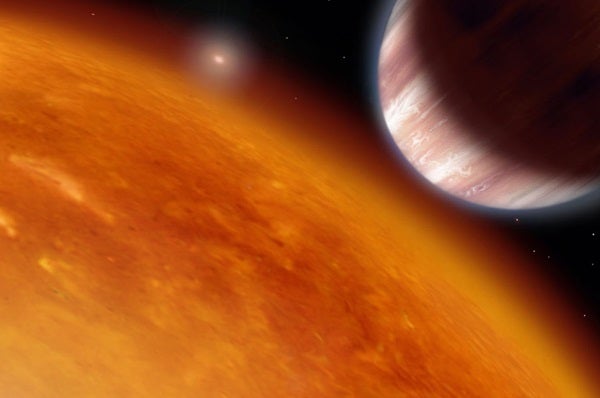A recent addition to the 200-member list of worlds beyond our solar system stands above the crowd. The planet orbits a star 450 light-years from Earth and is the largest planet found to date, measuring 36-percent wider than Jupiter. The catch: Planet HAT-P-1b also has the lowest density of any planet yet found.
Astronomers have located most extrasolar planets indirectly; a planet’s gravity pulls on its parent star, creating a detectable wobble. But 14, including HAT-P-1b, have been found as the planet transits — passes in front of — the parent star. This technique, which requires a direct line-of-sight, enables researchers to measure the planet’s mass and size accurately.
HAT-P-1b turns out to be one-quarter as dense as water. That’s half Jupiter’s density, or roughly the density of cork. It orbits its star, one half of a binary system in Lacerta, once every 4.5 days — 20 times closer than Jupiter. The planet passes across the star’s face in the span of 2 hours. Researchers have found other planets orbiting stars at an even closer range, but none have the low density of this one. For example, the newly-discovered TrES-2 is 1.28 times Jupiter’s mass and orbits its star just 3.4 million miles (5.5 million kilometers) distant. The planet XO-1b is just 10-percent lighter than Jupiter and circles in an eccentric orbit that brings it even closer.
“The picture of what is going on has become murkier rather than clearer,” says David Latham from the Harvard-Smithsonian Center for Astrophysics and a member of the discovery team. “There are some ideas about how to make ‘fluffy’ low-density gas-giant planets, but no one explanation has emerged as being the compelling one.”
Researchers have suggested tidal heating from an eccentric orbit as a possible mode for heating up such a large planet internally, but the orbit of HAT-P-1b does not favor this explanation. Another possibility is that the planet’s spin axis is tipped, much like Uranus’. However, the physics necessary for this configuration make this option a remote possibility.
Before the discovery of HAT-P-1b, scientists knew of only one other world with such a low density. The planet HD 209458b orbits a 7th-magnitude star in the constellation Pegasus. Since its discovery in 1999, this planet was widely considered to be a fluke. But with the discovery of HAT-P-1b, some scientists now believe low-density super-giants may represent an entirely new class of bodies.
Planet-hunter David Jewitt of the University of Hawaii cautions that the lightweight behemoths may simply be “one more type” in the ever-expanding menagerie of extrasolar planets. Latham agrees: “I don’t think of HAT-P-1 as representing a new class of planets, but rather as an extreme example of the population of planets that we are finding by the transit method, which is strongly biased to find the biggest ones.”
Another remarkable aspect of the planet’s discovery concerns the tools used to find it. The gas super-giant was detected using the Hungarian Automated Telescope, a network of six small robotic telescopes: four at Arizona’s Wipple Observatory and two atop Hawaii’s Mauna Kea. The team’s results will appear in a future issue of Astrophysical Journal Letters.










